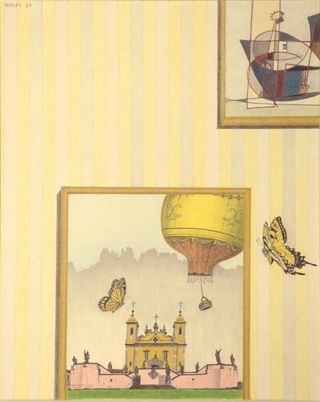Churches (1956)

Churches: Congonhas do Campo
1956 ink and colored pencil on paper 15 x 13½ in
Ripley was fascinated by eighteenth-century Brazilian sculptor Aleijadinho ("the Little Cripple"), who suffered amputation of his fingers but with tools tied to his wrists went on to sculpt the medallions, doorways, and statues that made Minas Gerais a rich center of the Brazilian baroque. His most famous works are the twelve statues that front Bom Jesus de Matosinhos in Congonhas do Campo.
Ripley's homage to Aleijadinho was combined with his delight in the formalist arguments of his critic friend, Clement Greenberg, to result in a series of "Churches" in which the commentary seems burned away and only an affectionate, apprehensive irony remains. On the same wallpaper with the baroque edifice in Congonhas do Campo he placed a Victorian pleasure balloon and a modernist painting by Italian artist Afro Basaldella. Years later, an art that posed the moral and aesthetic equivalence of styles would be called postmodernist.–abridged from Douglas Crase, Both: A Portrait in Two Parts, 203-4.

Churches: Ouro Prêto
1956 ink and colored pencil on paper 13 x 15½ in

Beinecke Rare Book & Manuscript Library, Yale
Rupert Barneby, Dwight Ripley, Clement Greenberg 1951
No one delighted in modern art more than Dwight, but piety was not one of his attributes. –John Bernard Myers, Tracking the Marvelous.